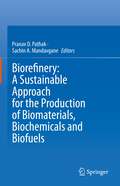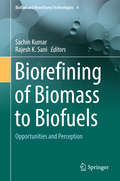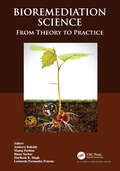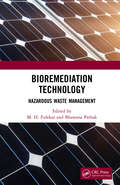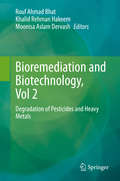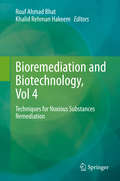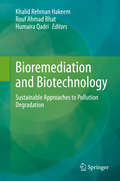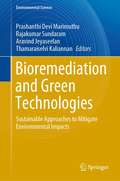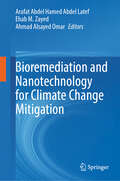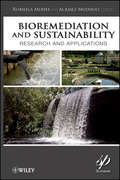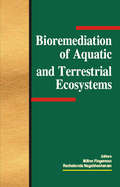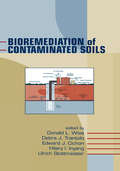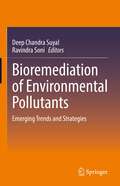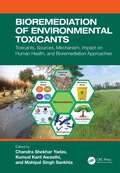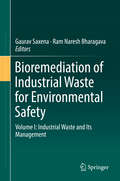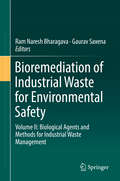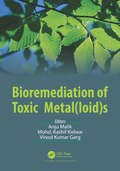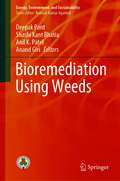- Table View
- List View
Biorefinery: A Sustainable Approach for the Production of Biomaterials, Biochemicals and Biofuels
by Pranav D. Pathak Sachin A. MandavganeThis book discusses recent trends and concepts in the field of biorefinery. It discusses optimal and economic strategies for converting biomass to value-added products to maximize profits with minimal environmental impact with a sustainability approach. The chapters of the book are focused on the current technologies, techno-economical aspects, life cycle assessment, and case studies. The book is divided into three sections; the first section presents strategies for the production of biofuels like bioethanol, biomethane, biohydrogen, bio-oil, gasification, etc., from the biomass in a sustainable way. The second sections review the extraction of bioactive chemicals, phenolic antioxidants, enzymes, and carboxylic acid from the biomass residue. The last section examines the utilization of biomass for the production of bioactive materials, including biofertilizers, bioadsorbents, activated carbon, nano-materials, and pigments. This book explores the relation between biofuels and the sustainable development goals (SDGs) 7.
Biorefining of Biomass to Biofuels: Opportunities and Perception (Biofuel and Biorefinery Technologies #4)
by Sachin Kumar Rajesh K. SaniThis volume focuses on the prospects of the conversion of biomass into biofuels including ethanol, butanol, biogas, biohydrogen, biodiesel, syn-gas and other useful products. Biomass-derived fuels have gained tremendous attention worldwide. However, due to high raw material and processing costs, biofuels produced from lignocelluloses have been found to be more expensive than conventional fuels. Therefore, a concept of biorefining has been introduced, where more than one product or each and every component of biomass may be derived into useful products in a manner of petroleum refinery.
Bioregionalism
by Michael Vincent McGinnisBioregionalism is the first book to explain the theoretical and practical dimensions of bioregionalism from an interdisciplinary standpoint, focusing on the place of bioregional identity within global politics. Leading contributors from a broad range of disciplines introduce this exciting new concept as a framework for thinking about indigenous peoples, local knowledge, globalization, science, global environmental issues, modern society, conservation, history, education and restoration. Bioregionalism's emphasis on place and community radically changes the way we confront human and ecological issues.
Bioremediation Protocols (Methods in Biotechnology #2)
by David SheehanLeading researchers from around the world present their best genetic, chemical, and analytical techniques for studying specific pollutants and their remediation. Their expert procedures range widely from cell immobilization and screening to microbiological and analytical chemistry methods that are applied to such environmental pollutants as hydrocarbons, PAHs, PCBs, TBT, and heavy metals. These pathbreaking contributors have also included illuminating reviews and case studies intended to expand the useful range of the methods, and they discuss such major issues in bioremediation as the design and use of bioreactors, genetic manipulation, and the preparation and analysis of environmental samples.
Bioremediation Science: From Theory to Practice
by Amitava Rakshit, Manoj Parihar, Binoy Sarkar, Harikesh B. Singh and Leonardo Fernandes FracetoThis book provides state of the art description of various approaches, techniques and some basic fundamentals of bioremediation to manage a variety of organic and inorganic wastes and pollutants present in our environment. A comprehensive overview of recent advances and new development in the field of bioremediation research are provided within relevant theoretical framework to improve our understanding for the cleaning up of polluted water and contaminated land. The book is easy to read and language can be readily comprehended by aspiring newcomer, students, researchers and anyone else interested in this field. Renowned scientists around the world working on the above topics have contributed chapters. In this edited book, we have addressed the scope of the inexpensive and energy neutral bioremediation technologies. The scope of the book extends to environmental/agricultural scientists, students, consultants, site owners, industrial stakeholders, regulators and policy makers.
Bioremediation Technology for Plastic Waste
by Mohd. Shahnawaz Manisha K. Sangale Avinash B. AdePlastic is one of the widely used polymers around the globe since its discovery. It is highly impossible to think the ease of life without the aid of plastic. Every year billion tons of plastic waste gets accumulated in the environment and leads to death of both marine and terrestrial animals. Plastic is very durable and needs around 1000 years to degrade under the natural environment. The present book illustrates the importance and significance of the bioremediation to tackle the problem of plastic waste. Previously, we have reported elite rhizobacterial isolates (Lysinibacillus fusiformis strain VASB14/WL and Bacillus cereus strain VASB1/TS) of Avicennia marina Vierh (Forsk.) from the West Coast of India with the potential to degrade plastic (polythene). The present book attempted to address the bioremediation scenario of plastic waste (including micro plastic) using microbes with bacteria in particular. Various strategies used to tackle with the plastic waste were highlighted with case studies of plastic waste management, including in vitro, in situ and ex situ with a special reference to biodegradation technology. After the biodegradation of the plastic using microbes, the generated plastic (polythene) degradation products (PE-DPs) were also documented using GC-MS technique followed by their deleterious effect on both animal and plant systems. The book also enhances the awareness of the plastic-free society and also suggests some alternative materials to be used instead of plastic. Lastly, the book suggests/recommends the strategies to be followed by the lawmakers in the government organizations/non-government organizations/social organizations to frame the regulations and guidelines to implement at mass level to reduce the generation of plastic waste.
Bioremediation Technology: Hazardous Waste Management
by M. H. Fulekar Bhawana PathakThe book describes hazardous waste industries, sources of waste generation, characterization and treatment processes/ methods and technique and technology to deal with the treated waste as per the prescribed standard. Advanced treatment based on the microbial remediation, plant-based decontamination, rhizoremediation and nano-based remediation is also explained. Advances in treatment technology using biotechnological tools/bionanotechnology for removal of contaminants are described. This volume will help readers to develop biotechnological and nanotechnological approaches for the remediation of hazardous waste and the developed technology that can be transferred from laboratory to land and piloting to commercial scenarios. Prof. M. H. Fulekar a Professor and Joint Director (R&D), Centre of Research for Development, Parul University. Dr. Bhawana Pathak is working as an Associate Professor and Dean in School of Environment and Sustainable Development, Central University of Gujarat.
Bioremediation and Biotechnology, Vol 2: Degradation of Pesticides and Heavy Metals
by Khalid Rehman Hakeem Rouf Ahmad Bhat Moonisa Aslam DervashThis book addresses the grave concerns stemming out due to conventional treatment techniques. The main focus of this book revolves round the central kernel of novel technology (bioremediation and biotechnology) which has emerged as an independent warrior to clean up and restore the disturbed environs. Furthermore, this book is a coherent assortment of diverse chapters relevant to the role of biotechnology and bioremediation for restoration of the ecosystems degraded by pesticide and heavy metal pollution. The inaugural chapters deal with the quantification of problem and its magnitude due to pesticides and heavy metals, followed by innovative modern biotechnological and bioremediation treatment technologies and sustainable techniques to remediate the persistent pollutants. It is a detailed comprehensive account for the treatment technologies from unsustainable to sustainable. Academicians, researchers and students shall find it as a complete wrap up regarding biotechnological intervention for sustainable treatment of pollution and shall suffice for the diverse needs of teaching and research.
Bioremediation and Biotechnology, Vol 3: Persistent and Recalcitrant Toxic Substances
by Khalid Rehman Hakeem Rouf Ahmad Bhat Najla Bint Saud Al-SaudHealthy environment is important for any kind of biota on earth. It provides the basic elements of life such as clean water, fresh air, fertile soil and supports ecosystem of the food chain. Pollution drastically alters quality of the environment by changing the physico-chemical and biological aspects of these components. Accordingly, toxic metals, combustible and putrescible substances, hazardous wastes, explosives and petroleum products are all examples of inorganic and organic compounds that cause contaminations. Specifically, pollution of toxic and heavy metal in the environment is a growing problem worldwide, currently at an alarming rate. Toxic metals threaten the aquatic ecosystems, agriculture and ultimately human health. Traditional treatment techniques offer certain advantages such as rapid processing, ease of operation and control and flexibility. But, they could not maintain the quality of the environment due to the high operational costs of chemicals used, high energy consumption and handling costs for sludge disposal and overburden of chemical substances which irreversibly affect and destroy biodiversity, which ultimately render the soil useless as a medium for plant growth. Therefore, bioremediation and biotechnology, carried out by living assets to clean up, stabilize and restore contaminated ecosystems, have emerged as promising, environmental friendly and affordable approaches. Furthermore, the use of microbes, algae, transgenic plants and weeds adapted to stressful environments could be employed to enhance accumulation efficiency. Hence, sustainable and inexpensive processes are fast emerging as a viable alternative to conventional remediation methods, and will be most suitable for developing countries.In the current volume, we discuss pollution remediation challenges and how living organisms and the latest biotechnological techniques could be helpful in remediating the pollution in ecofriendly and sustainable ways.
Bioremediation and Biotechnology, Vol 4: Techniques for Noxious Substances Remediation
by Khalid Rehman Hakeem Rouf Ahmad BhatThe rapid thriving of industries, conversion of agricultural land to residential areas, habitat destruction, deforestation and use of recalcitrant synthetic substances enhanced the rate of degradation of the environment. Although there are various conventional techniques for degradation and cleaning of noxious pollutants from disturbed environs, they are energy inefficient and costly to install. Bioremediation has emerged recently as an alternative and novel approach to manage and control environmental pollutants. This volume focuses explicitly on the remediation of noxious substances in stressed environs. It includes expert-contributed chapters on bio-monitoring by way of evaluating the relationship of biota with the polluted/stressed environs, sustainable plant-based degradation of noxious pollutants, and the application of biotechnologies to achieve tailored responses.Academicians, researchers, scientists and students will find this work essential for sustainable treatment of noxious pollutants. This book also serves as a core guide for training, teaching and research in conservation biology and environmental rehabilitation.
Bioremediation and Biotechnology: Sustainable Approaches to Pollution Degradation
by Khalid Rehman Hakeem Humaira Qadri Rouf Ahmad BhatToxic substances threatens aquatic and terrestrial ecosystems and ultimately human health. The book is a thoughtful effort in bringing forth the role of biotechnology for bioremediation and restoration of the ecosystems degraded by toxic and heavy metal pollution. The introductory chapters of the book deal with the understanding of the issues concerned with the pollution caused by toxic elements and heavy metals and their impacts on the different ecosystems followed by the techniques involved in monitoring of the pollution. These techniques include use of bio-indicators as well as modern techniques for the assessment and monitoring of toxicants in the environment. Detailed chapters discussing the role of microbial biota, aquatic plants, terrestrial plants to enhance the accumulation efficiency of these toxic and heavy metals are followed by remediation techniques involving myco-remediation, bio-pesticides, bio-fertilizers, phyto-remediation and rhizo-filtration. A sizable portion of the book has been dedicated to the advanced bio-remediation techniques which are finding their way from the laboratory to the field for revival of the degraded ecosystems. These involve bio-films, micro-algae, genetically modified plants and filter feeders. Furthermore, the book is a detailed comprehensive account for the treatment technologies from unsustainable to sustainable. We believe academicians, researchers and students will find this book informative as a complete reference for biotechnological intervention for sustainable treatment of pollution.
Bioremediation and Green Technologies: Sustainable Approaches to Mitigate Environmental Impacts (Environmental Science and Engineering)
by Rajakumar Sundaram Aravind Jeyaseelan Thamaraiselvi Kaliannan Prashanthi Devi MarimuthuThis book offers insights into the recent research focusing on green solutions to address environmental pollution and its impacts. Bioremediation is a vast area that encompasses numerous innovative and cost-effective experimental and research methods involvingnumerous technologies, such as biotechnological, biochemical, microbial, marine, chemical and engineering approaches. Featuring original research and review articles by leading experts, the book explores potential solutions to the growing issues of waste management and environmental pollution and their impacts, and suggests future research directions. As such, it is a valuable resource for professionals and general readers alike.
Bioremediation and Nanotechnology for Climate Change Mitigation
by Arafat Abdel Hamed Abdel Latef Ehab M. Zayed Ahmad Alsayed OmarThis book integrates various scientific approaches, including bioremediation and nanomaterials, to address environmental challenges posed by living organisms. It serves as a crucial guide for decision-makers, providing a scientific foundation for tackling issues within the circular economy paradigm. By introducing innovative methods for improving environmental conditions, the book facilitates the design of eco-friendly cities and revitalizes older urban areas. The chapters cover topics such as the current state and future of international environmental relations, the impact of population growth on pollution, and recent advances in sustainable waste management. Readers will discover insights into the relationship between air pollution, nanomaterials, and bioremediation, as well as the role of artificial intelligence as a predictive tool. The book also explores key pollution-related issues and presents effective remediation strategies. Special attention is given to the role of nanotechnology in addressing climate change, with chapters highlighting its applications in sustainable agriculture. This book is an invaluable resource for professionals, researchers, and graduate students engaged in advanced environmental science research. It reinforces fundamental remediation concepts while introducing the latest updates, maximizing readers' knowledge of sensor-based remediation. The book presents a multidisciplinary approach, integrating theoretical perspectives with practical case studies. Whether the reader is an academic, practitioner, or interested layperson, this book offers a wealth of information and insights into the future of environmental sustainability.
Bioremediation and Sustainability: Research and Applications
by Ackmez Mudhoo Romeela MoheeBioremediation and Sustainability is an up-to-date and comprehensive treatment of research and applications for some of the most important low-cost, "green," emerging technologies in chemical and environmental engineering.
Bioremediation for Sustainable Environmental Cleanup
by Vinod Kumar Garg Anju MalikThe present book, Bioremediation for Sustainable Environmental Cleanup, has a compilation of seventeen chapters comprehensively describing the state-of-the-art on emerging bioremediation approaches employed for sustainable environmental clean-up of diverse environmental pollutants such as metal(loid)s, polycyclic aromatic hydrocarbons, dyes, pesticides, petroleum hydrocarbons, etc., by using bacteria, fungi, algae, higher plants, and novel materials like biohybrids, nano-biomaterials, and graphitic carbon nitride (g-C3N4). Different bioremediation strategies such as biosorption, bioprecipitation, bioaccumulation, biodegradation, biotransformation etc. have been described in detail. The emphasis throughout, however, is on sustainable environmental clean-up. Eminent researchers from various countries located in diverse geographical areas, including Argentina, Canada, Germany, India, Pakistan, South Africa, the United Kingdom, and the United States of America, have contributed towards the chapters of this book.
Bioremediation of Agricultural Soils
by Juan C. Sanchez-HernandezThe quality of agricultural soils are always under threat from chemical contaminants, which ultimately affect the productivity and safety of crops. Besides agrochemicals, a new generation of substances invades the soil through irrigation with reclaimed wastewater and pollutants of organic origin such as sewage sludge or cattle manure. Emerging pollutants such as pharmaceuticals, nanomaterials and microplastics are now present in agricultural soils, but the understanding of their impact on soil quality is still limited. With focus on in situ bioremediation, this book provides an exhaustive analysis of the current biological methodologies for recovering polluted agricultural soils as well as monitoring the effectiveness of bioremediation.
Bioremediation of Aquatic and Terrestrial Ecosystems
by Milton FingermanBioremediation, the use of microorganisms to degrade, sequester, or remove environmental contaminants, is an urgent need of our planet for protection and restoration from toxic contaminants. This book not only provides cutting edge information about bioremediation of aquatic and terrestrial habitats, but also highlights the gaps in our knowledge of
Bioremediation of Contaminated Soils (Environmental Science & Pollution)
by Donald L. WiseThis volume focuses on innovative bioremediation techniques and applications for the cleanup of contaminated media and sites. It includes quantitative and design methods that elucidate the relationships among various operational parameters, and waste chemistry that defines the cost effectiveness of bioremediation projects. It also presents numerica
Bioremediation of Environmental Pollutants: Emerging Trends and Strategies
by Ravindra Soni Deep Chandra SuyalThis book collates the latest trends and technological advancements in bioremediation, especially for its monitoring and assessment.Divided into 18 chapters, the book summarizes basic concepts of waste management and bioremediation, describes advancements of the existing technologies, and highlights the role of modern instrumentation and analytical methods, for environmental clean-up and sustainability.The chapters cover topics such as the role of microbial fuel cells in waste management, microbial biosensors for real-time monitoring of bioremediation processes, genetically modified microorganisms for bioremediation, application of immobilized enzyme reactors, spectroscopic techniques, and in-silico approaches in bioremediation monitoring and assessment. The book will be advantageous not only to researchers and scholars interested in bioremediation and sustainability but also to professionals and policymakers.
Bioremediation of Environmental Toxicants: Toxicants, Sources, Mechanism, Impact on Human Health, and Bioremediation Approaches
by Kumud Kant Awasthi Mahipal Singh Sankhla Chandra Shekhar YadavBioremediation of Environmental Toxicants: Toxicants, Sources, Mechanism, Impact on Human Health, and Bioremediation Approaches provides insight into the nature of environmental toxicants, the impact on human health, and their bioremediation approaches, viz. nanotechnology, microorganism, and phytoremediation. Various environmental toxicants such as pesticides, heavy metals, plastic and microplastic waste, dyes used in industries, colorants, corrosive agents, and biomedical waste show different levels of mechanism of toxicity, possessing a significant threat to human health as well as the stability of ecosystems. To decontaminate the environment from these toxic compounds a low-cost effective technique is required. Bioremediation is a sustainable approach by which hazardous pollutants are converted into less harmful or non-toxic compounds using effective techniques to detoxify contaminated soil and water. In recent years, research has steadily concentrated on the various bioremediation approaches, viz. nanoparticle, microorganism, and phytoremediation.KEY FEATURES Showcases contributions from high-profile experts in the field Highlights the current state and importance of environmental bioremediation Provides detailed knowledge about the mechanism, toxicity, and action of environmental toxicants Furnishes a deep understanding of environment–human interaction and the after effects Outlines the state-of-the-art bioremediation technologies, viz. nanotechnology, microbial- and plant-based mitigation of environmental toxicants
Bioremediation of Industrial Waste for Environmental Safety: Volume I: Industrial Waste and Its Management
by Ram Naresh Bharagava Gaurav SaxenaAchieving environmental sustainability with rapid industrialization is a major challenge of current scenario worldwide. As globally evident, industries are the key economic drivers, but are also the major polluters as untreated/partially treated effluents discharged from the industries is usually thrown into the aquatic resources and also dumped unattended. Industrial effluents are considered as the major sources of environmental pollution as these contains highly toxic and hazardous pollutants, which reaches far off areas due to the medium of dispersion and thus, create ecological nuisance and health hazards in living beings. Hence, there is an urgent to find ecofriendly solution to deal with industrial waste, and develop sustainable methods for treating/detoxifying wastewater before its release into the environment. Being a low cost and eco-friendly clean technology, bioremediation can be a sustainable alternative to conventional remediation technologies for treatment and management of industrial wastes to protect public health and environment. Therefore, this book (Volume I) covers the bioremediation of different industrial wastes viz. tannery wastewater, pulp and paper mill wastewater, distillery wastewater, acid mine tailing wastes, and many more; which are lacking in a comprehensive manner in previous literature at one place. A separate chapter dedicated to major industries and type of waste produced by them is also included. This book will appeal to students, researchers, scientists, industry persons and professionals in field of microbiology, biotechnology, environmental sciences, eco-toxicology, environmental remediation and waste management and other relevant areas, who aspire to work on the biodegradation and bioremediation of industrial wastes for environmental safety.
Bioremediation of Industrial Waste for Environmental Safety: Volume II: Biological Agents and Methods for Industrial Waste Management
by Ram Naresh Bharagava Gaurav SaxenaAchieving environmental sustainability with rapid industrialization is currently a major global challenge. Industries are the key economic drivers, but are also the main polluters as untreated/partially treated effluents from industry are usually discharged into the aquatic environment or dumped. Industrial effluents often contain highly toxic and hazardous pollutants, which cause ecological damage and present and health hazards to living beings. As such, there is a pressing need to find ecofriendly solutions to deal with industrial waste, and to develop sustainable methods for treating/detoxifying waste before it’s released into the environment. As a low cost and eco-friendly clean technology, bioremediation can offer a sustainable alternative to conventional remediation technologies for the treatment and management of industrial wastes. This book (Volume II) describes the role of biological agents in the degradation and detoxification of organic and inorganic pollutants in industrial wastes, and presents recent bioremediation approaches for waste treatment and management, such as constructed wetlands, electro- bioremediation and nano-bioremediation, as well as microbial fuel cells. It appeals to students, researchers, scientists, industry professionals and experts in the field of microbiology, biotechnology, environmental sciences, eco-toxicology, environmental remediation and waste management and other relevant areas who are interested in biodegradation and bioremediation of industrial wastes for environmental safety.
Bioremediation of Recalcitrant Compounds
by Jeffrey W. TalleyThis authoritative text addresses the latest in bioremediation technologies for three difficult-to-treat contaminant groups: chlorinated solvents, PCBs, and PAHs - one of the most complex and expensive areas of applied remediation engineering.Bioremediation of Recalcitrant Compounds assesses innovative R&D projects developed for each contam
Bioremediation of Toxic Metal(loid)s
by Vinod Kumar Garg Anju Malik Mohd Kashif KidwaiThe book, Bioremediation of Toxic Metal(loid)s, describes the state-of-the-art and potential of emerging technologies on bioremediation of toxic metal(loid)s. It has a compilation of the available comprehensive knowledge of the fundamentals and advancements in the field of bioremediation of toxic metal(loid)s. The mechanisms, applications, and current advancements of various bioremediation strategies used for metal(loid)s have been described in 21 chapters contributed by leading experts from different institutes, universities, and research laboratories from various countries across the globe including Argentina, Canada, Chile, Colombia, France, India, Japan, Republic of Korea, the United Kingdom, and the United States of America. This book offers a bird’s eye view on various bioremediation technologies based on a variety of biological agents viz. plants, bacteria, algae, fungi etc., used for environmental clean-up of toxic metal(loid)s.
Bioremediation using weeds (Energy, Environment, and Sustainability)
by Deepak Pant Shashi Kant Bhatia Anil K. Patel Anand GiriIn this monograph, the core elements of multidisciplinary bioremediation practices are addressed and environmental pollutants which can be effectively remediated using weeds is focused upon. Weeds plants can easily grow in waste dumping sites with their rapidly colonizing ability. The contents include recent results in bioremediation and focuses on the current trend of introduction of potentials of weeds in bioremediation practice. This volume will be a useful guide for researchers, academics and scientists.^
